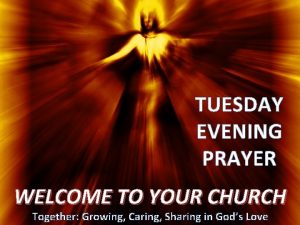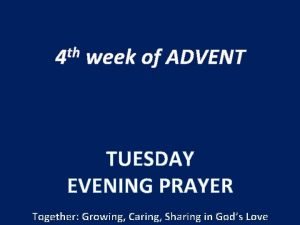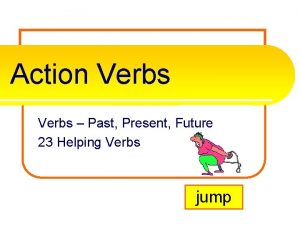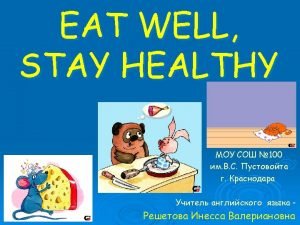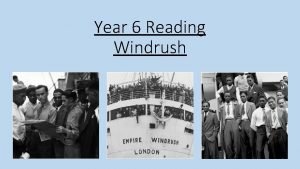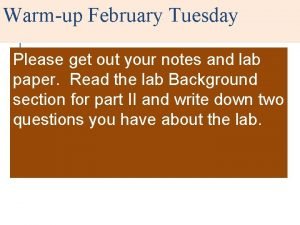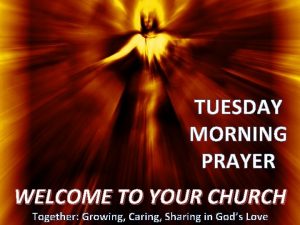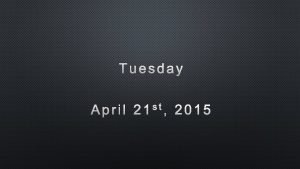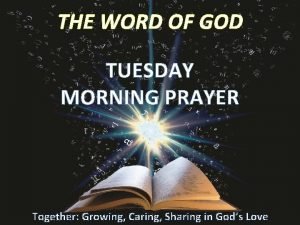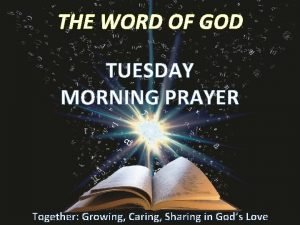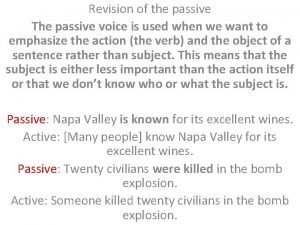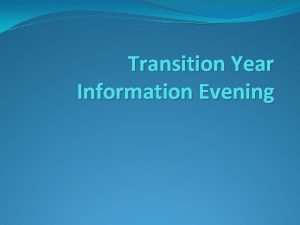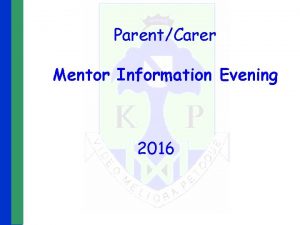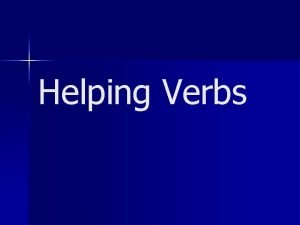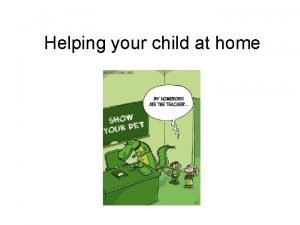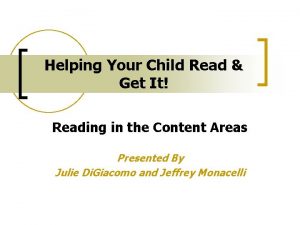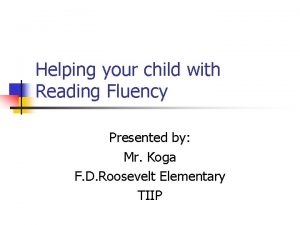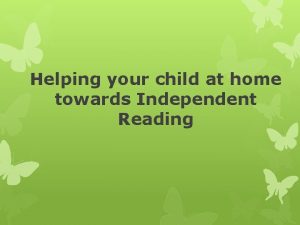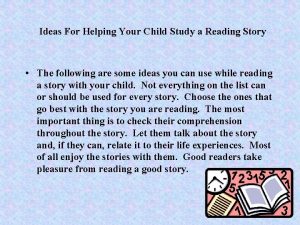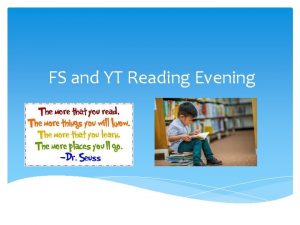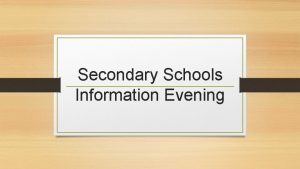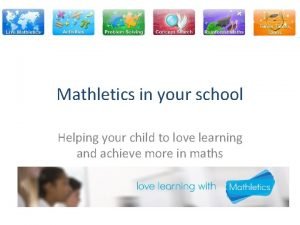HELPING YOUR CHILD WITH READING Information Evening Tuesday




















- Slides: 20

HELPING YOUR CHILD WITH READING Information Evening Tuesday 11 th October 2011

Our aim is to give your child the skills to be able to read … • For a purpose • For pleasure

Contexts for reading in school • Reading individually with the teacher or TA • Daily phonics sessions • Independent reading • Shared reading • Specific reading tasks • Guided reading • Reading in other subjects such as history or science • ICT

Children learn to read successfully when • Reading in school is partnered with reading at home on a regular basis This is crucial in supporting children’s development as independent, confident readers.

What can you read at home? • Reading scheme books for your child to read. • ‘Real’ books – you can share the reading with your child if the text is tricky. • Read books to your child. • Share both story books and information books. • Get books from the library. • Comics. • Websites. • Cookery books, leaflets, labels, signs, maps. • … anything with text!

When sharing books with your child at home • Support your child with their phonics skills to help them work out new words. • Talk about the book and the pictures. • Predict what might happen. • Retell parts of the story. • Talk about how the characters might be feeling. • Discuss and explain funny/scary/favourite parts. • Think about similar stories and story patterns.

Keys to successful reading at home • Enjoy it! • Be positive. • Make it into a special time, rather than a chore. • Take over the reading if your child is tired or struggling. • Let your child see that reading is important by doing it yourself! • A good 10 minutes is better than a difficult half hour! • Little and often works well for younger children. • If your child is not enjoying a particular book, select a new one together.

What is phonics? • Phonics is a method of teaching reading and spelling based on breaking words down into their smallest units of sound. • A phoneme is the smallest unit of sound in a word. • A grapheme is the letter or group of letters that represents a phoneme.

Why do we teach phonics? • Learning to read is a vitally important skill. • Without it children will find it harder to access other areas of the curriculum. • Phonics is the key method for children to learn to read and spell words • We use Letters and Sounds as the structure for teaching phonics. • Phonics teaching is divided into 6 phases or levels. • Phonics teaching is supported by Jolly Phonics in Reception.

Phase 1, Letters and Sounds Phase 1 focuses on differentiating between sounds. This is taught in Nursery and will continue into Reception. We explore • Sounds in the environment • The difference between sounds of percussion instruments • Rhythm and rhyme • Voice sounds • Alliteration – words that all begin with the same initial sound eg Sammy Snake is Sad.

Phase 2, Letters and Sounds Children are taught the first smallest units of sound, or phonemes. s a t i p n ck e h r m d Jolly phonics is a multi-sensory method of learning phonics.

Pronunciation Correct pronunciation of these sounds is very important when reading with your child. n – u – t blending incorrect sounds makes nuuhtu n – u – t blending correct sounds makes nut. Jolly Phonics pronunciation of phonemes http: //jollylearning. co. uk/2010/10/29/hear-the-letter-sounds/

Blending and segmenting At Phase 2 children who are ready will start to • Blend when reading eg. c – a – t makes cat • Segment for writing eg. dog – I can hear d – o – g. Writing at this stage is likely to be using letter cards or magnetic letters, rather than a pencil.

Phase 3, Letters and Sounds Children start to learn • The final single letter sounds in the alphabet eg. y, q • The alphabet names of letters • Some digraphs (two letters stuck together that make one sound, such as oo in boot or ai in rain. • Simple ‘tricky’ words that can not be sounded out such as the, she, I

How do children learn at Phase 3? • Reading and writing activities • Games based learning • Use of whiteboards for practise in class • Learning to recognise digraphs as two letters stuck together r – ai – n sh – ee – p • Using sound buttons to emphasise the phonemes in a word r – ai – n sh – ee – p. _. .

Phase 4, Letters and Sounds This is a short phase which aims to consolidate children’s reading/spelling of words which have consonants together at the beginning or end of words. Eg c l a p. . b u m p. .

Phase 5, Letters and Sounds Children at this phase learn • a broader range of phonemes, including ‘trigraphs’ (3 letters stuck together that say one sound) eg. igh, air • Split digraphs (magic ‘e’) eg fame, time, phone • More ‘tricky’ words, such as people, old

Phase 6, Letters and Sounds This overlaps with the Support for Spelling programme in Year 3. It focuses on • Spelling patterns • Prefixes and suffixes • Plurals

Which phase should my child be on and when? • Reception teaching focuses on Phase 2 and 3 • From half term, Mrs Salemme will teach phonics at Phase 3 and 4 and Mrs Gregg will teach phonics at Phase 5 and 6. There is some overlap between the phases. Children will be taught at the phase that is appropriate to their needs and pace of learning, so that no child is held back or pressured to move on before they are ready. Therefore, teachers will assess the needs of their class and children will be taught at the phase that is appropriate for their stage of learning.

Websites with phonics games http: //www. letters-and-sounds. com/phase-2 -games. html (There also games for phases 3 -5) http: //www. bbc. co. uk/schools/ks 1 bitesize/literacy/phonics/index. shtml http: //www. ngfl-cymru. org. uk/vtc/ngfl-flash/alphabet-eng/alphabet. htm (Demonstrates sounds and formation of letters a-z) http: //www. phonicsplay. co. uk (A range of games – select the Phase level and sounds for your child) http: //www. literactive. com/Download/live. asp? swf=story_files/mouse_house_U S. swf (Matching capital and lower case letters) http: //www. crickweb. co. uk/ks 1 literacy. html (creating 3 letter words)
 Which word
Which word Tuesday evening prayer
Tuesday evening prayer Evening prayer
Evening prayer Tuesday evening prayer
Tuesday evening prayer Is would a helping verb
Is would a helping verb While reading activities
While reading activities Year 7 information evening
Year 7 information evening Help your mother
Help your mother 승자트리
승자트리 Give us your hungry your tired your poor
Give us your hungry your tired your poor John agard windrush child poem
John agard windrush child poem Monday tuesday wednesday thursday friday calendar
Monday tuesday wednesday thursday friday calendar Factors affecting solubility
Factors affecting solubility What college did morrie and mitch first meet
What college did morrie and mitch first meet Saturday morning prayer
Saturday morning prayer Feathered friend by arthur c clarke
Feathered friend by arthur c clarke Tuesday morning prayers
Tuesday morning prayers Tuesday morning prayer gif
Tuesday morning prayer gif Stock market crash cartoon 1929
Stock market crash cartoon 1929 Black tuesday political cartoon
Black tuesday political cartoon John gave a bar of chocolate to jill
John gave a bar of chocolate to jill

